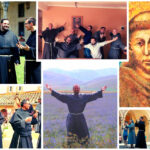8. The Situation in Non-Christian Lands
The Church deeply desired missionary activity ad gentes, even before the time of St. Francis. One of its strongest promoters was Pope St. Gregory the Great. Thanks to his efforts, a number of Benedictines initiated activities across Europe. Thus, St. Augustine of Canterbury preached the Gospel in England, St. Boniface served the lands inhabited by the Germanic peoples and St. Adalbert went to Hungary and Bohemia. In turn, another wave of Benedictines contributed to the conversion of Scotland, Ireland and Scandinavia. One should also mention the mission of Saints Cyril and Methodius among the Slavic peoples. As one can see, the “missionary spirit” was not a foreign concept at the beginning of the 12th century, before the appearance of St. Francis. However, the reasons behind the evangelizing effort were different. Some evangelizers were convinced that they had to help bring about the conversion of all peoples before the world ended. Others wanted to be perfectly obedient to Christ’s command to preach the Gospel.
The activity of the Church was also expressed through armed conflict because of the holy war against Islam. Attempts to evangelize Muslims began relatively late. In the past, the Church’s evangelization efforts were mainly directed towards the peoples of Europe. At that time, the Muslims were considered adversaries of Christianity. An example of this was the situation in the Iberian Peninsula, which was then largely occupied by Arabs. The Church thought more about how to defeat and destroy them, than how to evangelize them. Only in the 13th century was there any serious consideration about converting these peoples to the Christian faith. Popes Gregory IX and Innocent IV sent several bulls through the mediation of the mendicant orders, hoping to bring the Mohammedans to the Church.
During the time of St. Francis, Arabs dominated coastal North Africa. There was, however, one notable exception. In 1212, after the Sultan of Morocco lost the battle of Las Navas de Tolosa, he granted a little more freedom to the Christians, especially the Spanish soldiers. He allowed them to build churches and even baptize Moroccans. It seems the situation did not last long, because the first Franciscan missionaries were martyred in Morocco in 1220. In other countries under Islamic domination, such as Egypt, Palestine and Spain, Muslims were discouraged from embracing Christianity on penalty of death, and the same was imposed upon the missionaries who sought to convert them.
The situation for Christians in the Holy Land was quite uncomfortable, since those territories were also under Islamic domination. At that time, the Crusades became a weapon to counter this. The decisive moment that sent Christians into battle against Muslims was the occupation of Jerusalem in 1187. The preservation of pilgrimages to the Holy Land became the overriding reason for Christians to defend themselves, and also to attack and reconquer the sacred places. Recruitment drives for more Crusaders were carried out by word of mouth and in writing. There were even attempts made to stimulate the popular imagination by showing images of Jesus, covered in blood. This was to indicate that Mohammad had contributed to the Lord’s suffering and death. The various Orders of Knights, which had previously helped the people, especially the sick and those making pilgrimages to Jerusalem, were also incorporated into the Crusader armies. One should mention that those who died while trying to liberate the Holy Land were assured of salvation. Indeed, martyrdom suffered during a Crusade was considered a sure way to heaven.
This was the era in which St. Francis appeared, with his desire to preach the Gospel in non-Christian lands.
Friar Dariusz MAZUREK General Delegate for Missionary Animation
Based upon:
Gemelli A., Franciszkanizm, Warsaw Francisco de Asís entre Conversión del Mundo Cristiano y Conversión del Mundo Islámico. ¿Una Relación Atípica?, in: Para Mejor Conocer a San Francisco de Asís, Oñate (Guipúzcoa) 1997.1988.
Manselli R., Francisco de Asís entre Conversión del Mundo Cristiano y Conversión del Mundo Islámico. ¿Una Relación Atípica?, in: Para Mejor Conocer a San Francisco de Asís, Oñate (Guipúzcoa) 1997.
Micó J., La Evangelización entre Los Infieles, Selecciones de Franciscanismo 63 (1992) 239-352.
Rocha M., San Francisco. El Profeta de Asís, Selecciones de Franciscanismo 16 (1977) 19-27.
Santos Hernández A., Las Misiones Católicas, in: Historia de la Iglesia, vol. XXIX, Valencia 1978.
For more information about missions, go to Facebook at:
https://www.facebook.com/AnimazioneFrancescana/
See also the Instagram account of the Mission Secretariat at:
https://www.instagram.com/sgam_ofmconv/














